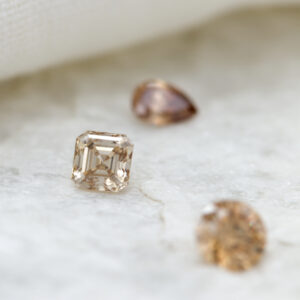The rise of lab grown diamonds in the marketplace over the last 5 years has been quite rapid and to me quite surprising. Having had family in the diamond business for over 25 years, I was a bit of a purist and couldn’t quite get my head around the lab grown phenomenon. Over time however, I have come to appreciate that lab grown diamonds have a place in the market.
Firstly – what is a lab grown diamond? According to GIA, laboratory-grown diamonds, as per their name, refer to the fact that they are created in a laboratory or factory rather than occurring in nature and mined from the earth. It is only their origin which sets laboratory-grown diamonds apart from natural ones, since laboratory-grown diamonds have essentially all of the same chemical, optical and physical properties and crystal structure as natural diamonds.
The Lab grown diamonds I have seen look exactly the same as natural diamonds. There is no way I could tell the difference even with the basic tools I have here in the showroom. Their identity can usually only be determined by gemological laboratories using specialised instruments. These instruments detect minor differences in trace elements and crystal growth to determine whether a diamond is laboratory-grown or natural.
So why would you choose a lab grown diamond over a mined diamond? There are a couple of reasons, the number one being price. I have just investigated the current prices and as an example, a 1 ct Round Brilliant Cut Diamond F Colour and VS2 Clarity Mined Diamond is over 4 x the price of the lab grown option. The gap between the two is getting greater as many articles I have read over the last year state the difference as only 30 – 50%.
Another main reason people choose lab grown are due to environmental and ethical concerns. Mining obviously can have a detrimental affect on the physical environment and there is a lot of water and energy involved in the mining process. Alternately, while lab grown don’t have the same impact on the ground, there is still the energy factor. There has not been a lot of transparency in the lab grown industry about how much energy it takes to produce a single diamond. There are definitely some labs that are really conscious and leave a very low carbon footprint and others purely seeking on profits with no concern for the environment at all.
There is no right or wrong answer when it comes to lab-grown over mined diamonds. Both options serve a purpose and have merit. In summary below we list some pros and cons for each:
Lab grown diamond pros
- Price – they are considerably more affordable
- Can be grown using 100 per cent renewable energy
- Are chemically identical to natural diamonds
Lab grown diamond cons:
- Investment value yet to be proven (many predict they will have little to no resale value as the sector grows and supply outstrips demand)
- They are a product of technology, not nature, which for some people lacks emotional punch
- They don’t currently have inherent positive social impact nor do they support millions of livelihoods
- There is a lack of transparency in how much energy they use
Natural diamond pros:
- Gem quality diamonds are a finite resource, so their rarity is inherent
- They are ancient, formed within the earth billions of years ago
- They support tens of millions of people around the world
- They are a valuable natural resource that can support the economies of entire countries
- They have greater resale value, and in some cases, investment value
Natural diamond cons:
- Mining is carbon intensive, often relying on diesel-run machinery
- Diamond mining uses large amounts of water, energy, and earth
- A small percentage of diamonds mined in unregulated conditions are still making it into the general supply chain
So there is a place for both. At Hope Diamonds we can supply both Mined and Lab Grown Diamonds and are very conscious about being open and transparent about both. For any further questions about either get in touch today here.





